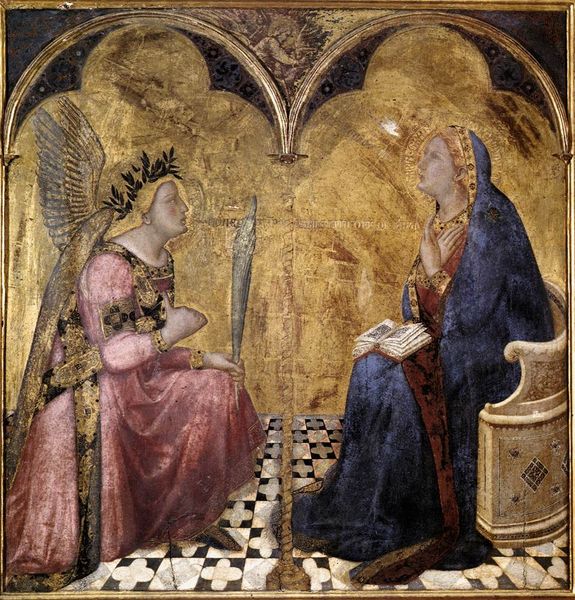
#
abstract painting
#
prophet
#
sculpture
#
possibly oil pastel
#
tile art
#
fluid art
#
underpainting
#
naive art
#
mythology
#
painting painterly
#
surrealist
#
chaotic composition
Copyright: Public domain
Curator: This is Filippino Lippi’s "The Coronation of the Virgin," created around 1480. What are your first thoughts? Editor: There's a gentle harmony to the colours; a serene balance with the careful symmetry that immediately strikes me. The palette feels muted, almost as if it is viewed through a veil. Curator: Consider that this piece would have likely been intended to assert the spiritual and political power structures. Here, God, embodied as a regal figure, crowns the Virgin, re-inscribing conventional hierarchies. How does the Virgin's submissive pose play into that power dynamic, do you think? Editor: Visually, I'm drawn to the dynamic interplay between the figures and the surrounding space. The arc-shaped composition focuses the viewer's eye, with soft draperies creating a rhythm of line and form. Curator: Right, and this kind of idealized presentation of the feminine aligns, of course, with prevailing social ideals and constraints for women. It is not about earthly women, of course, but symbolic of the Church, but, importantly, not an actively powerful role, more a conduit. Editor: Semiotically speaking, consider the colour. The white is symbolic of purity. It directs our reading of the artwork—we are given signs, but they lack any disruption to that surface meaning, I feel. The semiotics appear very closed, actually, because they all seem to be harmonized. Curator: Let us not forget though, Lippi paints this scene within a very specific cultural and theological context, following well-worn tropes—while also contributing his style. Editor: Yes, but the figures almost appear to be floating—with little weight and not firmly grounded, though. I am drawn to that fact that there appears a strong departure from an overly symbolic, structured setting—yet Lippi never abandons that sense of order, balance. It’s visually beautiful, which I recognize as the success of the work as a composition. Curator: Yes, thinking critically about its place and reception can help us view that ‘beauty’ in relation to complex systems of belief, gender, and influence. Editor: Absolutely. I find it satisfying that the artist can play within the rules yet challenge my expectations.
Comments
No comments
Be the first to comment and join the conversation on the ultimate creative platform.













